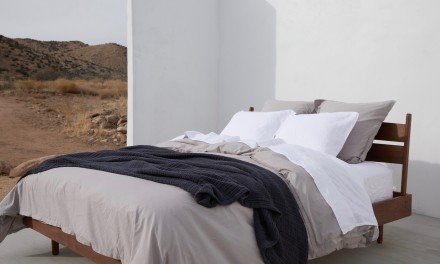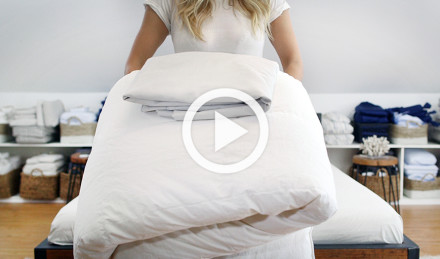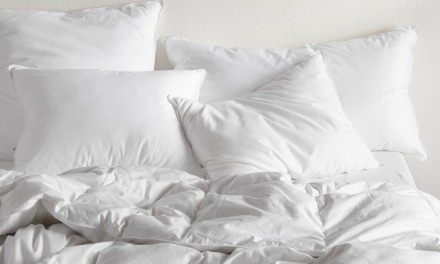The perfect sleeping environment is different for everyone. Some like to be ultra-cozy and warm, and others prefer lower temps and cooler materials. While your ideal bedding depends on your body temperature, fabric preferences and taste, many people swear by percale.
With an elegant yet not overly fancy hotel-like appearance, it's easy to see why the fabric is such a popular choice for sheets and other textiles. But what is percale, and what are percale sheets made of? Read on for a breakdown of percale, including how it's made, the pros and cons of the material and how it compares to other fabrics.
What is Percale?
Percale has a plain weave, meaning it's woven in a basic criss-cross pattern. What makes it unique from other plain-weave materials is that it's tightly woven from long, fine threads. Known for its smooth, flat finish and high-end appearance, the fabric can be used to make curtains, towels, pajamas, nightgowns, shirts and other types of clothing. Thanks to its breathability and cool, crisp feel, percale is most often made into sheets. We're talking top sheets, fitted sheets and even crib sheets. You can also get percale duvet covers, pillowcases and shams. It's the perfect fabric for layering a beautiful bedscape.
What is Percale?
Percale has a plain weave, meaning it's woven in a basic criss-cross pattern. What makes it unique from other plain-weave materials is that it's tightly woven from long, fine threads. Known for its smooth, flat finish and high-end appearance, the fabric can be used to make curtains, towels, pajamas, nightgowns, shirts and other types of clothing. Thanks to its breathability and cool, crisp feel, percale is most often made into sheets. We're talking top sheets, fitted sheets and even crib sheets. You can also get percale duvet covers, pillowcases and shams. It's the perfect fabric for layering a beautiful bedscape.
How is Percale Fabric Made?
Percale is typically made of long-staple cotton (LSC). The fibers come from a cotton species called Gossypium barbadense (also known as sea island cotton). These extra-long, silky strands are ideal for creating percale's super-tight plain weave.
To make the fabric, the yarns are woven over and under, alternating between a vertical (warp) thread and a horizontal (weft) thread, with a tight-knit structure. The technique makes percale not only durable but also notably smooth and soft. While you might think such a tight weave would make the fabric heavy, it's actually impressively lightweight and breathable. Lear more about how to care for percale in our guide.
Types of Percale
As mentioned, percale is usually 100% cotton. However, other natural materials like silk and bamboo can be woven into the fabric. Lots of people prefer 100% cotton, but blended fabrics are sometimes a little warmer and resistant to wrinkles.
Cotton percale sheets and other bedding can vary in terms of thread count, which usually maxes out at about 400. Having said that, a higher thread count doesn't automatically mean higher quality, as there aren't any regulations about how threads are counted. A better indicator of bedding quality is the type of cotton used and where it comes from. Percale bedding sourced from long-staple cotton in Egypt (Egyptian cotton) is generally considered a more premium option than LSC grown in the U.S.
How is Percale Fabric Made?
Percale is typically made of long-staple cotton (LSC). The fibers come from a cotton species called Gossypium barbadense (also known as sea island cotton). These extra-long, silky strands are ideal for creating percale's super-tight plain weave.
To make the fabric, the yarns are woven over and under, alternating between a vertical (warp) thread and a horizontal (weft) thread, with a tight-knit structure. The technique makes percale not only durable but also notably smooth and soft. While you might think such a tight weave would make the fabric heavy, it's actually impressively lightweight and breathable. Lear more about how to care for percale in our guide.
Types of Percale
As mentioned, percale is usually 100% cotton. However, other natural materials like silk and bamboo can be woven into the fabric. Lots of people prefer 100% cotton, but blended fabrics are sometimes a little warmer and resistant to wrinkles.
Cotton percale sheets and other bedding can vary in terms of thread count, which usually maxes out at about 400. Having said that, a higher thread count doesn't automatically mean higher quality, as there aren't any regulations about how threads are counted. A better indicator of bedding quality is the type of cotton used and where it comes from. Percale bedding sourced from long-staple cotton in Egypt (Egyptian cotton) is generally considered a more premium option than LSC grown in the U.S.
Is Percale Bedding Right For You?
There's a lot to love about cotton percale bed sheets, but will they deliver your most relaxing, comfortable, refreshing shut-eye? Considering the pros and cons of the material can help figure out if it's right for you.
Benefits of Percale Bedding:
Natural material
Smooth, cool and crisp to the touch
Moisture-wicking
Breathable and lightweight
Doesn't trap heat
Luxurious, high-end appeal
Strong and durable
Resistant to tears and pilling
Low maintenance
Softer with every wash
Suitable for year-round use
Potential Drawbacks of Percale:
Non-insulating
Not as warm as other materials
More prone to wrinkling than other fabrics
People who run hot at night and those who live in warm climates tend to be big fans of percale, as the light, breathable fabric doesn't trap heat. And since air can pass through the material, it wicks away sweat while you sleep and helps you stay dry during the hot, humid summer. While plenty of people sleep in percale bedding year-round, others may want something a little more insulating during the winter.
Is Percale Bedding Right For You?
There's a lot to love about cotton percale bed sheets, but will they deliver your most relaxing, comfortable, refreshing shut-eye? Considering the pros and cons of the material can help figure out if it's right for you.
Benefits of Percale Bedding:
Natural material
Smooth, cool and crisp to the touch
Moisture-wicking
Breathable and lightweight
Doesn't trap heat
Luxurious, high-end appeal
Strong and durable
Resistant to tears and pilling
Low maintenance
Softer with every wash
Suitable for year-round use
Potential Drawbacks of Percale:
Non-insulating
Not as warm as other materials
More prone to wrinkling than other fabrics
People who run hot at night and those who live in warm climates tend to be big fans of percale, as the light, breathable fabric doesn't trap heat. And since air can pass through the material, it wicks away sweat while you sleep and helps you stay dry during the hot, humid summer. While plenty of people sleep in percale bedding year-round, others may want something a little more insulating during the winter.
How to Care for Percale Bedding
Like other types of cotton, percale is relatively low maintenance. In most cases, it can be washed in a washing machine and dried in a dryer. That said, your best bet is to run your percale bedding through a cold cycle using mild laundry detergent and then tumble-dry it on a low-heat setting. Tossing in a couple of wool dryer balls can make the fabric extra fluffy and cut down on drying time.
You can clean percale sheets and pillowcases as often as you'd like, but we recommend washing them about once a week. The first time you wash your bedding, it might shrink ever so slightly, but that shouldn't affect the size or fit. After that, the material is unlikely to shrink. And even though it has a tight weave, cotton percale can stretch back out to its original size — just like cotton clothing.
If the fabric is wrinkly after washing, you can iron it. However, it won't have as many creases if you take it out of the dryer when it's still warm. And it should smooth out when you make your bed. Another perk of percale is that it gets softer with every wash. The material's durability makes it last a long time too, so you can enjoy progressively softer bedding for years.
How Does Percale Compare to Other Bedding Materials?
It's a good idea to review your options before settling on a bedding fabric. So, what's the difference between percale and sateen? How about brushed cotton and linen? Here's what you should know.
Percale vs. Sateen Sheets
How Does Percale Compare to Other Bedding Materials?
It's a good idea to review your options before settling on a bedding fabric. So, what's the difference between percale and sateen? How about brushed cotton and linen? Here's what you should know.
Percale vs. Sateen Sheets
Percale and sateen are both high-quality cotton fabrics. The main differences have to do with weave and sheen. With percale bedding, you'll have a plain square weave and a matte finish. Sateen, on the other hand, is created using a complex satin weave, giving it a lustrous appearance with a subtle shine.
All in all, percale is known for being crisp and flat, whereas sateen is a bit silkier and more drapey. The weaving technique of sateen also makes it a little warmer than percale.
Percale vs. Brushed Cotton Sheets
Similar to flannel, brushed cotton is finished with a brushing technique to lift the fibers and create an extra-cozy, insulating surface. The unbeatably soft material feels a lot like a beloved lived-in t-shirt. Those who get cold at night tend to appreciate this type of bedding. It can be used year-round, but it's usually a more popular choice in the winter.
Since percale is a cooler material, it's better suited for the warmer balmy months, especially in humid areas. With that said, some people like to switch out their bedding each season, so you might consider brushed cotton in the winter and percale in the summer.
Percale vs. Linen Sheets
Linen is another naturally sourced fabric, but instead of cotton fibers, it's made from flax plants. Known for being light, airy and breathable, linen is one of the most sought-after choices for premium bedding.
Like percale, linen gets softer over time and can last for several years. Generally speaking, linen is stronger than cotton, but durable percale gives it a run for its money.
Pima Percale vs. Egyptian Percale Sheets
Not all percale bedding is created equal. As we said, long-staple cotton comes from the Gossypium barbadense plant, which is often grown in Egypt but can also be cultivated almost anywhere in the world.
Egyptian cotton is a type of premium percale. To carry the Egyptian cotton label, the fabric has to be woven from certified long-staple cotton fibers produced in Egypt. Pima percale (named after the Pima Indian Reservation in Arizona) is usually made of long-staple cotton grown in the Southwestern United States.
In the world of bedding, Egyptian percale is typically viewed as superior to Pima. The raw fibers are longer and finer, which makes for an incredibly soft and luxurious fabric. It also tends to be stronger and more resistant to pilling.
Premium Percale Bedding from Parachute
Percale is cool and flat, strong but not heavy, and undeniably smooth. For many, it checks all the boxes. The percale bedding from Parachute is made of top-notch long-staple Egyptian cotton, woven at our factory in Portugal and gently combed to remove any imperfections. It's then dyed using safe, natural pigments and garmented washed to make it as soft and comfy as possible the first time you use it.
Premium Percale Bedding from Parachute
Percale is cool and flat, strong but not heavy, and undeniably smooth. For many, it checks all the boxes. The percale bedding from Parachute is made of top-notch long-staple Egyptian cotton, woven at our factory in Portugal and gently combed to remove any imperfections. It's then dyed using safe, natural pigments and garmented washed to make it as soft and comfy as possible the first time you use it.
Some say percale is like hotel bedding; others compare it to a perfectly pressed dress shirt. In any case, it's crisp, clean and classy with a casual texture. What's not to love?
Percale may not be for everyone — or everything. Most people can agree the naturally cooling material is ideal for sheets, but you can always mix and match. You could go with percale pillowcases and sheets and then get a linen duvet cover and shams. Or maybe you prefer cozier sheets and a lighter top layer. In that case, you might opt for brushed cotton sheets with a percale duvet.
Parachute carries some of the best percale sheets, pillowcases, duvet covers and shams on the market. They come in a few sophisticated yet laid-back neutral hues, including white, cream, sand, light grey, slate and blush. There's a good chance it'll be love at first sleep, but if you're still not sure, order a swatch to feel it yourself before committing to the fabric.








